This article was co-authored by Jonathan Frank, MD. Dr. Jonathan Frank is an Orthopedic Surgeon based in Beverly Hills, California, specializing in sports medicine and joint preservation. Dr. Frank's practice focuses on minimally invasive, arthroscopic surgery of the knee, shoulder, hip, and elbow. Dr. Frank holds an MD from the University of California, Los Angeles School of Medicine. He completed an orthopedic residency at Rush University Medical Center in Chicago and a fellowship in Orthopedic Sports Medicine and Hip Preservation at the Steadman Clinic in Vail, Colorado. He is a staff team physician for the US Ski and Snowboard Team. Dr. Frank is currently a scientific reviewer for top peer-reviewed scientific journals, and his research has been presented at regional, national, and international orthopedic conferences, winning several awards including the prestigious Mark Coventry and William A Grana awards.
There are 12 references cited in this article, which can be found at the bottom of the page.
wikiHow marks an article as reader-approved once it receives enough positive feedback. This article received 26 testimonials and 100% of readers who voted found it helpful, earning it our reader-approved status.
This article has been viewed 1,412,724 times.
A knee may appear swollen from an injury to the tendons, ligaments or meniscus. Other medical problems such as arthritis might contribute to swelling in the knee joint. Even overuse can make your knees swollen.[1] The swelling might be within the knee joint or in the surrounding tissue. People call the latter “water on the knee.” After you diagnose a swollen knee, you can try some home remedies. If your knee remains swollen or is painful, you should see a medical professional for advice and treatment.
Steps
Diagnosing a Swollen Knee
-
1Compare your affected knee with your other knee. Look for puffiness around the kneecap or around the sides of the knee. Comparing your two knees is a good way to check to see if there is swelling or redness and to see if is something wrong.
- There might also be swelling at the back of your knee. This could signal a Baker's cyst, which is when extra fluid is pushed into tissue behind your knee. It can cause swelling at the back of your knee which may worsen when you stand up.[2]
- If your affected knee is redder and warmer to the touch than the other knee, see your doctor.
-
2Bend and straighten your leg. If you have discomfort when you move your leg, you may have some level of injury that needs to be treated. You may feel this discomfort as pain, pressure or stiffness. The stiffness and/or pressure will most likely be due to fluid in your knee.[3]Advertisement
-
3Test walking on your leg. An injured leg may be painful to stand on. Try putting your weight on your leg and walking to see if your leg can handle load bearing exercise.
-
4See your doctor. While you may be able to diagnose swelling in your knee, you may not know the exact cause behind the swelling. It's best to check with your doctor if the swelling is persistent, painful, or doesn't go away in a couple of days.[4]
- Some possible conditions that cause knee swelling include: an injury such as a torn ligament or cartilage; irritation from exerting your knee too much; osteoporosis; rheumatoid arthritis; gout; infection; bursitis; or other conditions.[5]
Getting Professional Treatment
-
1Make an appointment with your doctor. Go to the doctor if there is significant swelling or if you can't bear weight on the knee. You should also visit the doctor if there is any obvious deformity or if you have a fever and redness in your knee, which may indicate an infection. Also see the doctor if you don't notice improvement after about 4 days. Your ligaments might be damaged.
- Your doctor will evaluate your knee to determine what condition is causing the swelling. He may administer an imaging test such as an x-ray, ultrasound or MRI. These tests will detect bone, tendon or ligament injuries.
- Another procedure that your doctor may try is an aspirate of the joint knee fluid to check for infection based upon the number of white cells and bacteria in the fluid.[6]
- Your doctor may inject a steroid into your knee to try to reduce the swelling.
- Finally, the doctor will take your temperature to make sure that you do not have an infection of the knee.
-
2Ask about surgery. Depending on the condition causing knee swelling, your doctor may recommend that you get surgery. Some of the most common types of knee surgery are:[7]
- Arthrocentesis: Fluid is removed from your knee to relieve joint pressure.
- Arthroscopy: Loose or damaged tissue is removed from around the knee.
- Joint replacement: You can get a replacement knee joint if it becomes clear that your knee is not getting any better and your knee pain is intolerable.
-
3Visit a physical therapist. Your doctor may prescribe physical therapy. A physical therapist will examine your leg. They will also give you specific exercises, based on your condition, to strengthen the muscles around the knee joint.[8]
-
4Visit an orthopedist. Foot problems like flat feet and other conditions may contribute to knee pain and swelling. Visit a foot specialist and ask this person to assess your feet. They might recommend that you wear orthotics, which are inserts that go inside your shoes.
- The orthopedist may need to assess your back and hip as well. Pain resulting from the back, hip, or feet is called referred pain.
Preventing Swollen Knees
-
1Wear knee pads. If you spend a significant amount of time sitting on your knees, such as for landscaping or housework, wear cushioned knee pads.
- If possible, take “micro breaks” of 10-20 seconds frequently. During these breaks, stand up and stretch your legs. Allow your legs to return to their resting position.
-
2Avoid knee bends and squatting. Repetitive motions that use your knees should be avoided if you want to prevent swollen knees.
-
3Refrain from high-impact exercise and sports. Many sports, especially those that require a lot of jumping and running, can be damaging to your knees. Avoid skiing, snowboarding, running, football, baseball, volleyball and basketball until your knees have healed completely.[9]
-
4Eat foods with anti-inflammatory properties. Your diet can contribute to increased risk for swelling in your knees or elsewhere in your body. Try to stay away from processed, fried or sugary foods. Increase your intake of fruits, vegetables, proteins and whole grains.
- Omega-3 fatty acids are high in anti-inflammatory properties. Eat more salmon and tuna to increase your omega-3 fatty acids.[10] Flaxseed oil is also a good source of omega-3 fatty acids.
- Try the Mediterranean diet. This diet is rich in lean protein such as fish and chicken. It also relies on lots of vegetables, olive oil, and beans.
-
5Avoid smoking. Smoking decreases the flow of oxygen and blood in your body. This in turn restricts the ability for tissue to repair itself.[11]
Trying Home Remedies
-
1Rest your knee. Stay off your leg and do as little walking as possible.
- Keep the knee elevated above your heart while lying down.[12] Prop the knee and foot on pillows or on the arm of the couch.
- Use crutches if it hurts to straighten the leg or to put weight on it.
- If you need crutches for more than a few days, you should see a medical professional because it may be something serious enough to require more than home care.
-
2Ice your knee. Apply ice directly on the swollen part of your knee for 10-20 minutes. Do this 3 times a day to reduce the swelling.[13] Wrap the ice in a towel or cloth before applying it to your skin to prevent ice burn or frostbite.[14]
- You can also use a frozen cold pack or a bag of frozen vegetables like peas instead of ice.
-
3Avoid heat for the first 48 hours. If you have sustained an injury that results in a swollen knee, avoid placing heat on your knee. This includes hot packs, hot showers, or hot tubs.[15]
-
4Use a compression bandage. Wrap your knee in an elastic bandage to apply compression. This will help decrease the swelling. Try an elastic bandage with a fastener that sticks to the bandage so that you don't need clips.
- You can purchase a compression bandage at a local pharmacy.
- Be careful not to wrap your knee too tightly. If you notice any numbness, tingling, odd coloring, or increased pain, your bandage is wrapped too tightly.
-
5Gently massage your knee. Massage at a very gentle rate may help increase blood flow to your knee. If anything hurts, refrain from massaging the painful area.[16]
-
6Alleviate pain with an over-the-counter pain reliever. Try an anti-inflammatory drug such as aspirin, acetaminophen, naproxen or ibuprofen - all are non-steroidal anti-inflammatory drug (NSAID). [17]
- When taking this type of pain reliever, be sure to carefully follow dosing instructions on the label.
- You can also try a topical painkiller. Talk with your pharmacist for proper application. You can also try a patch that contains the analgesic lidocaine for pain relief.
Exercises and Sports to Avoid with a Swollen Knee
Expert Q&A
Did you know you can get expert answers for this article?
Unlock expert answers by supporting wikiHow
-
QuestionCan a swollen knee go away on its own?
 Jonathan Frank, MDDr. Jonathan Frank is an Orthopedic Surgeon based in Beverly Hills, California, specializing in sports medicine and joint preservation. Dr. Frank's practice focuses on minimally invasive, arthroscopic surgery of the knee, shoulder, hip, and elbow. Dr. Frank holds an MD from the University of California, Los Angeles School of Medicine. He completed an orthopedic residency at Rush University Medical Center in Chicago and a fellowship in Orthopedic Sports Medicine and Hip Preservation at the Steadman Clinic in Vail, Colorado. He is a staff team physician for the US Ski and Snowboard Team. Dr. Frank is currently a scientific reviewer for top peer-reviewed scientific journals, and his research has been presented at regional, national, and international orthopedic conferences, winning several awards including the prestigious Mark Coventry and William A Grana awards.
Jonathan Frank, MDDr. Jonathan Frank is an Orthopedic Surgeon based in Beverly Hills, California, specializing in sports medicine and joint preservation. Dr. Frank's practice focuses on minimally invasive, arthroscopic surgery of the knee, shoulder, hip, and elbow. Dr. Frank holds an MD from the University of California, Los Angeles School of Medicine. He completed an orthopedic residency at Rush University Medical Center in Chicago and a fellowship in Orthopedic Sports Medicine and Hip Preservation at the Steadman Clinic in Vail, Colorado. He is a staff team physician for the US Ski and Snowboard Team. Dr. Frank is currently a scientific reviewer for top peer-reviewed scientific journals, and his research has been presented at regional, national, and international orthopedic conferences, winning several awards including the prestigious Mark Coventry and William A Grana awards.
Sports Orthopedic Surgeon & Joint Preservation Specialist To bring down the swelling, what you need to do is rest, ice the knee, compress it, and keep it elevated. Try putting a wrap on your knee and icing 20 minutes on and 20 minutes off. Elevate the knee above the heart level if you're laying on the couch or sitting. You can also use an anti-inflammatory like Ibuprofen or Naproxen to help counteract that inflammation.
To bring down the swelling, what you need to do is rest, ice the knee, compress it, and keep it elevated. Try putting a wrap on your knee and icing 20 minutes on and 20 minutes off. Elevate the knee above the heart level if you're laying on the couch or sitting. You can also use an anti-inflammatory like Ibuprofen or Naproxen to help counteract that inflammation. -
QuestionWhat can I do about chronic knee inflammation?
 Jonathan Frank, MDDr. Jonathan Frank is an Orthopedic Surgeon based in Beverly Hills, California, specializing in sports medicine and joint preservation. Dr. Frank's practice focuses on minimally invasive, arthroscopic surgery of the knee, shoulder, hip, and elbow. Dr. Frank holds an MD from the University of California, Los Angeles School of Medicine. He completed an orthopedic residency at Rush University Medical Center in Chicago and a fellowship in Orthopedic Sports Medicine and Hip Preservation at the Steadman Clinic in Vail, Colorado. He is a staff team physician for the US Ski and Snowboard Team. Dr. Frank is currently a scientific reviewer for top peer-reviewed scientific journals, and his research has been presented at regional, national, and international orthopedic conferences, winning several awards including the prestigious Mark Coventry and William A Grana awards.
Jonathan Frank, MDDr. Jonathan Frank is an Orthopedic Surgeon based in Beverly Hills, California, specializing in sports medicine and joint preservation. Dr. Frank's practice focuses on minimally invasive, arthroscopic surgery of the knee, shoulder, hip, and elbow. Dr. Frank holds an MD from the University of California, Los Angeles School of Medicine. He completed an orthopedic residency at Rush University Medical Center in Chicago and a fellowship in Orthopedic Sports Medicine and Hip Preservation at the Steadman Clinic in Vail, Colorado. He is a staff team physician for the US Ski and Snowboard Team. Dr. Frank is currently a scientific reviewer for top peer-reviewed scientific journals, and his research has been presented at regional, national, and international orthopedic conferences, winning several awards including the prestigious Mark Coventry and William A Grana awards.
Sports Orthopedic Surgeon & Joint Preservation Specialist If we're talking about chronic inflammation, you want to consider activity modification. For example, if you're a runner you may want to do lower impact activities like cycling, swimming, or using an elliptical. If you have severe arthritis, you may want to think about using an assist device like a cane or a walker. Anti-inflammatories like Ibuprofen or Naproxen can also address chronic inflammation.
If we're talking about chronic inflammation, you want to consider activity modification. For example, if you're a runner you may want to do lower impact activities like cycling, swimming, or using an elliptical. If you have severe arthritis, you may want to think about using an assist device like a cane or a walker. Anti-inflammatories like Ibuprofen or Naproxen can also address chronic inflammation. -
QuestionCan you reverse arthritis in your knees?
 Siddharth Tambar, MDDr. Siddharth Tambar, MD is a board certified rheumatologist at Chicago Arthritis and Regenerative Medicine in Chicago, Illinois. With over 19 years of experience, Dr. Tambar specializes in Regenerative Medicine and Rheumatology, with a focus on platelet rich plasma and bone marrow derived stem cell treatments for arthritis, tendinitis, injuries, and back pain. Dr. Tambar holds a BA in Economics from State University of New York at Buffalo. He earned his MD from State University of New York at Syracuse. He completed his Internship, Residency in Internal Medicine, and his Rheumatology Fellowship at Northwestern Memorial Hospital. Dr Tambar is board certified in both rheumatology and internal medicine. He also holds Musculoskeletal Ultrasound Diagnostic and Interventional certifications from the American College of Rheumatology and the American Institute of Ultrasound in Medicine.
Siddharth Tambar, MDDr. Siddharth Tambar, MD is a board certified rheumatologist at Chicago Arthritis and Regenerative Medicine in Chicago, Illinois. With over 19 years of experience, Dr. Tambar specializes in Regenerative Medicine and Rheumatology, with a focus on platelet rich plasma and bone marrow derived stem cell treatments for arthritis, tendinitis, injuries, and back pain. Dr. Tambar holds a BA in Economics from State University of New York at Buffalo. He earned his MD from State University of New York at Syracuse. He completed his Internship, Residency in Internal Medicine, and his Rheumatology Fellowship at Northwestern Memorial Hospital. Dr Tambar is board certified in both rheumatology and internal medicine. He also holds Musculoskeletal Ultrasound Diagnostic and Interventional certifications from the American College of Rheumatology and the American Institute of Ultrasound in Medicine.
Board Certified Rheumatologist Number one, if you've had an injury to the knee, you want to be thinking about how you can reduce stress on the knee. As you're doing certain types of physical activities, you may note soreness. Examine your technique and evaluate what may be putting more stress on that joint so that you can correct your form. You can also try reducing your weight if you have excess weight, as that can put stress on the knees.
Number one, if you've had an injury to the knee, you want to be thinking about how you can reduce stress on the knee. As you're doing certain types of physical activities, you may note soreness. Examine your technique and evaluate what may be putting more stress on that joint so that you can correct your form. You can also try reducing your weight if you have excess weight, as that can put stress on the knees.
References
- ↑ Jonathan Frank, MD. Sports Orthopedic Surgeon & Joint Preservation Specialist. Expert Interview. 31 July 2020.
- ↑ https://my.clevelandclinic.org/health/diseases/15183-bakers-cyst
- ↑ http://www.mayoclinic.org/diseases-conditions/swollen-knee/basics/symptoms/con-20026072
- ↑ Jonathan Frank, MD. Sports Orthopedic Surgeon & Joint Preservation Specialist. Expert Interview. 31 July 2020.
- ↑ http://www.mayoclinic.org/diseases-conditions/swollen-knee/basics/causes/con-20026072
- ↑ http://www.medscape.com/viewarticle/714757
- ↑ http://www.mayoclinic.org/diseases-conditions/swollen-knee/basics/treatment/con-20026072
- ↑ Jonathan Frank, MD. Sports Orthopedic Surgeon & Joint Preservation Specialist. Expert Interview. 31 July 2020.
- ↑ https://www.sparrow.org/departments-conditions/conditions/swollen-knee
- ↑ http://www.arthritis.org/living-with-arthritis/arthritis-diet/anti-inflammatory/eat-to-beat-inflammation.php
- ↑ https://orthoinfo.aaos.org/en/staying-healthy/smoking-and-musculoskeletal-health/
- ↑ Jonathan Frank, MD. Sports Orthopedic Surgeon & Joint Preservation Specialist. Expert Interview. 31 July 2020.
- ↑ https://www.sparrow.org/departments-conditions/conditions/swollen-knee
- ↑ Jonathan Frank, MD. Sports Orthopedic Surgeon & Joint Preservation Specialist. Expert Interview. 31 July 2020.
- ↑ https://www.scoi.com/patient-resources/education/articles/should-you-ice-or-heat-injury
- ↑ https://creakyjoints.org/alternative-medicine/massage-therapist-tips-for-arthritis/
- ↑ https://www.arthritis-health.com/types/general/how-care-swollen-knee
About This Article
Before you treat a swollen knee, assess your symptoms and try to figure out what’s causing the swelling. For example, if you have a swelling at the back of your knee, you may have a Baker’s cyst. If you have trouble moving your knee, it’s possible that your knee is injured. No matter what symptoms you have, it’s a good idea to get a diagnosis from a doctor. Depending on what’s causing your swelling, your doctor may recommend a variety of treatments, such as surgery, steroid injections, or physical therapy. If the swelling is related to an issue like flat feet, orthopedic shoes may help. Scroll down for more tips from our Medical co-author, including how to prevent knee swelling!




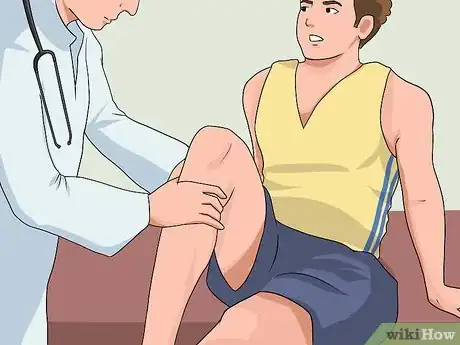
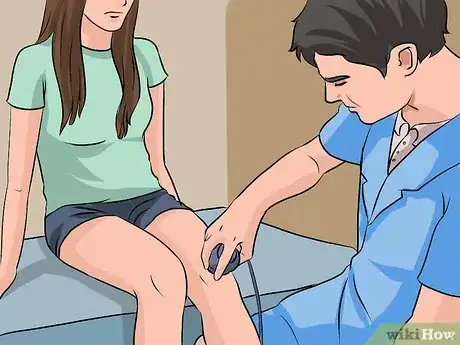

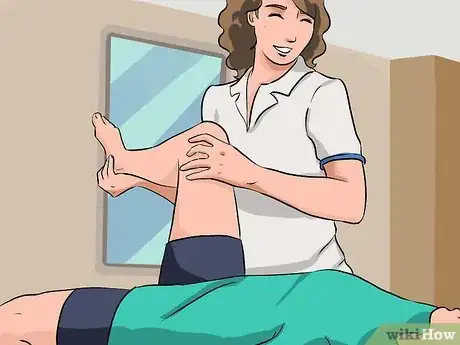



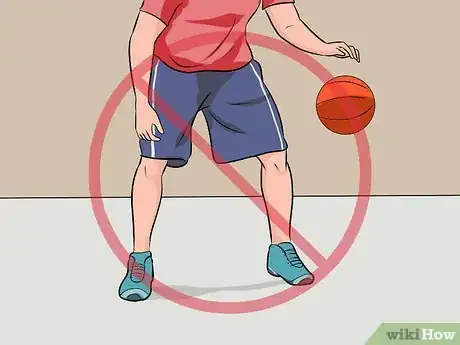

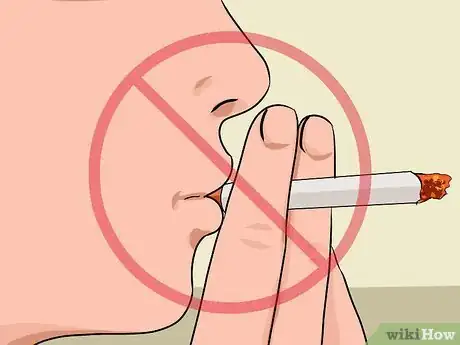
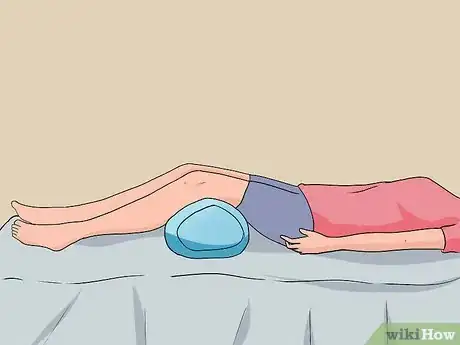
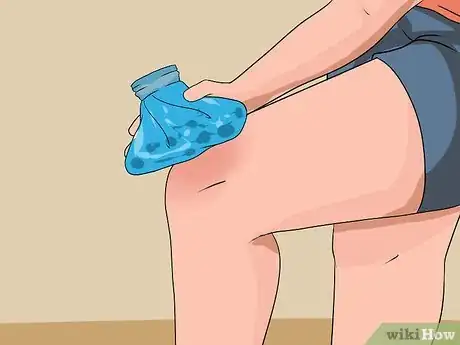

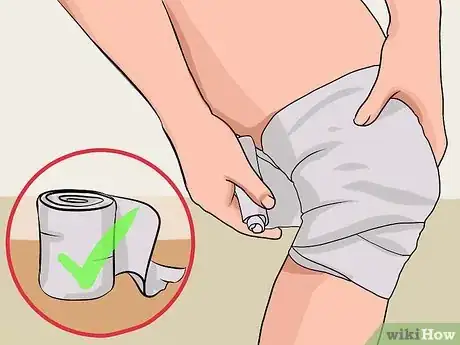
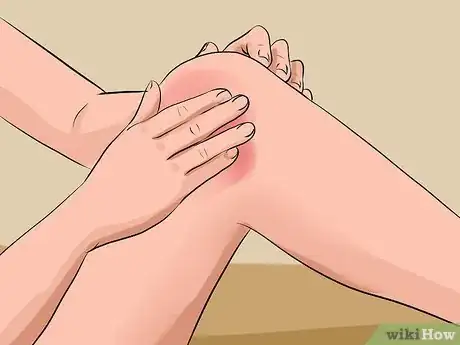
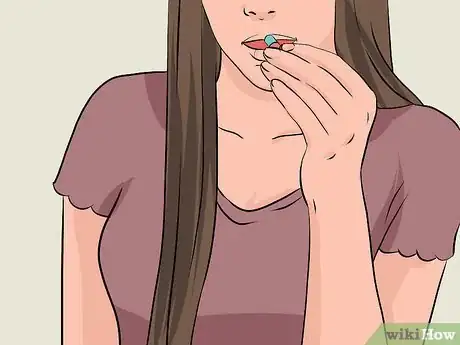


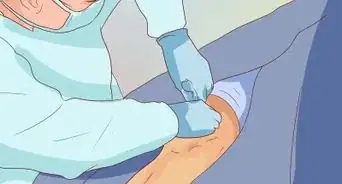


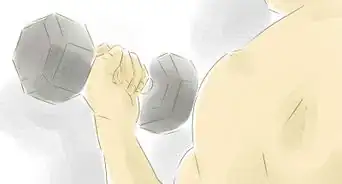

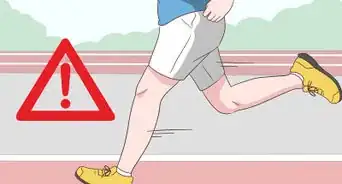


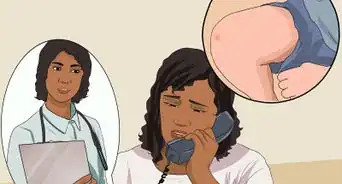

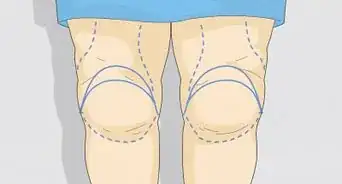
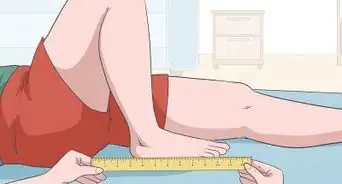











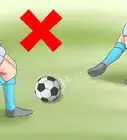






































Medical Disclaimer
The content of this article is not intended to be a substitute for professional medical advice, examination, diagnosis, or treatment. You should always contact your doctor or other qualified healthcare professional before starting, changing, or stopping any kind of health treatment.
Read More...